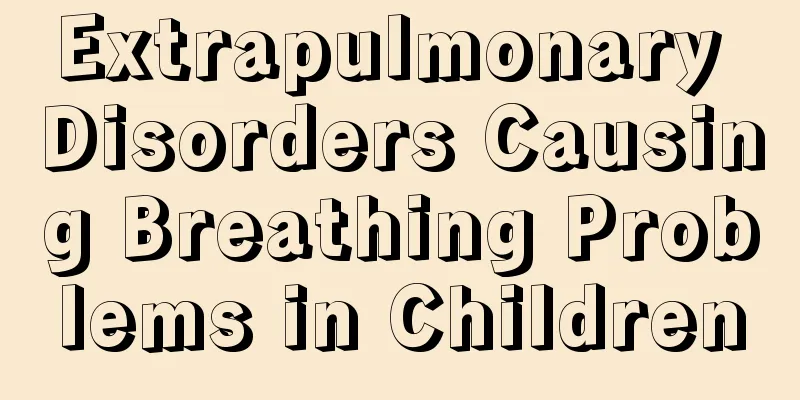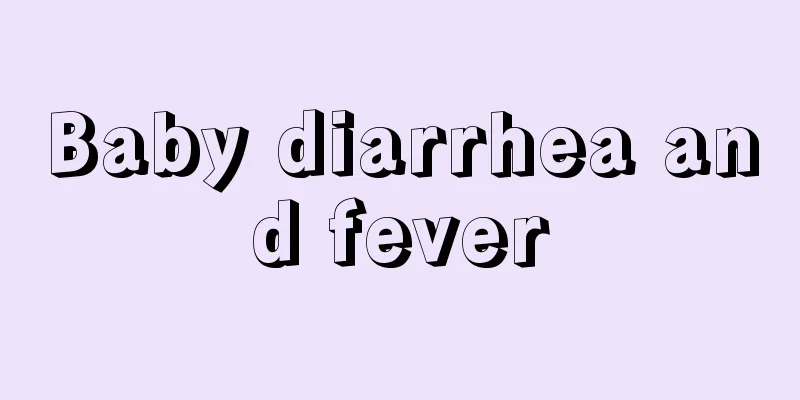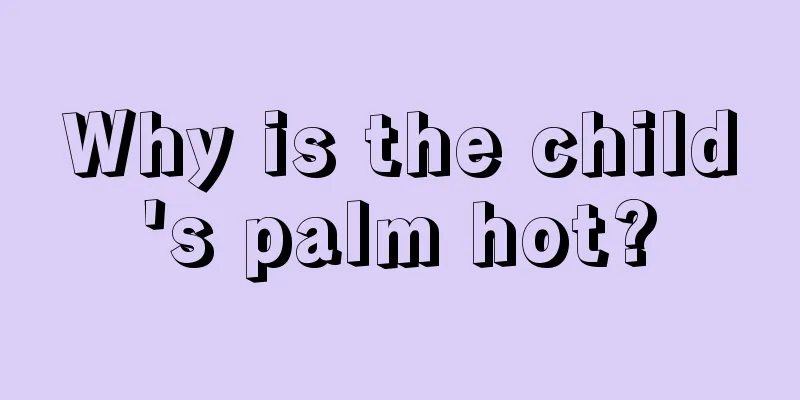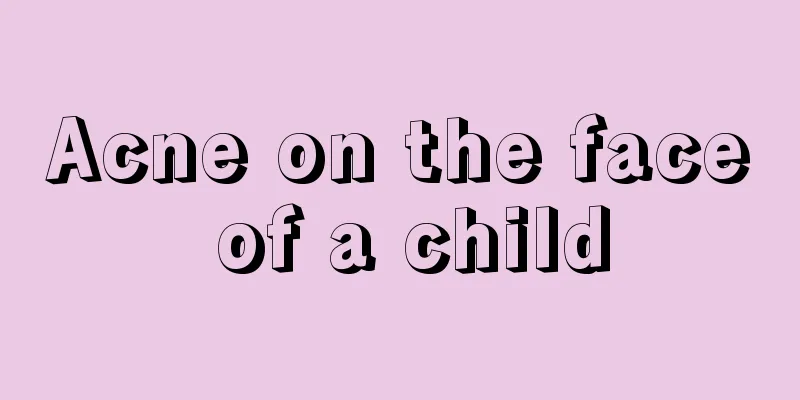Extrapulmonary Disorders Causing Breathing Problems in Children

|
Dyspnea in children is a relatively common disease. Because children's lungs are not fully developed, they are particularly prone to dyspnea in cold weather or other infections. Therefore, many parents want to fully understand the extrapulmonary diseases that cause dyspnea in children. In order for you to understand it as soon as possible, let's take a look at the detailed introduction below. Dyspnea refers to a symptom of difficulty breathing caused by various reasons. Most children cannot express their feelings, and only show varying degrees of changes in breathing rate, rhythm, depth, etc. In mild cases, the only noticeable difference is an increased respiratory rate (i.e., shortness of breath, abbreviated as "shortness of breath"); in severe cases, in addition to an increased respiratory rate, nasal flaring, nodding breathing, or the "three-depression sign" may occur, which may be accompanied by cyanosis. In addition to lung diseases, some extrapulmonary diseases can also cause dyspnea in infancy. Although these diseases are rare, they can easily lead to misdiagnosis and even cause serious consequences. Vitamin B1 deficiency (also known as beriberi) is clinically characterized by abnormal functions of the nervous system, cardiovascular system and digestive system. When vitamin B1 is deficient, it mainly causes glucose metabolism disorders, resulting in metabolic disorders in the nervous tissue, myocardium and skeletal muscle that mainly rely on glucose for energy. If myocardial metabolism is abnormal, acute heart failure is likely to occur, leading to breathing difficulties. Therefore, for infants with sudden unexplained pneumonia or heart failure, we should be alert to heart-type beriberi and use vitamin B1 for diagnostic treatment when necessary. Acute organophosphorus poisoning When children suffer from organophosphorus poisoning, the clinical manifestations are sometimes very atypical, and their toxic alkali-like symptoms generally appear early. If respiratory system signs are the main manifestations, such as fever, asthma, sputum, and dry or wet rales in the lungs, it is easy to be misdiagnosed as pneumonia or heart failure. For suspected cases, the history of exposure to organophosphorus pesticides should be thoroughly inquired, and the children should be carefully examined for specific signs of organophosphorus poisoning, such as pupil constriction, sweating, drooling, muscle fiber tremors, etc., and whole blood choline esterase activity should be measured in a timely manner. If necessary, atropine can be given for diagnostic treatment under close observation. Congenital diaphragmatic hernia is more common in newborns, and often occurs shortly after the child is born. A small number of diaphragmatic hernias on the left side without a hernia sac develop slowly several months or years after birth, and the symptoms are often atypical. Because the herniation of abdominal organs into the chest cavity mechanically compresses the heart and lungs, it can cause varying degrees of dyspnea or cyanosis, which can easily be misdiagnosed as lung disease. Chest X-ray examination is an important means of diagnosing diaphragmatic hernia, but it is easy to be misdiagnosed as hydropneumothorax, so we should be cautious. Acute intussusception Intussusception refers to a type of strangulated intestinal obstruction caused by part of the intestine and its mesentery being invaginated into the adjacent intestinal cavity. Its four major clinical manifestations are sudden onset of paroxysmal abdominal pain or paroxysmal crying, vomiting, bloody stools, and a sausage-like mass palpable in the abdomen. It is rare for people to have dyspnea in the early stages of intussusception. The main reason may be that the obstructive abdominal distension causes the diaphragm to lift up and mechanically compress the lung tissue. The main reason for shortness of breath in hypocalcemia may be that the excitation conduction function of electrical activity between various parts of the cerebral cortex of young infants is poor, and typical convulsions are not likely to occur clinically. However, the brainstem structure of young infants is relatively mature and can excite nearby tissues. If the excitement spreads to the respiratory center, changes in respiratory rhythm and frequency may occur. Therefore, some people believe that asthma or respiratory rhythm disorders caused by hypocalcemia can be regarded as a special form of convulsion. Intracranial hemorrhage Intracranial hemorrhage in infants is mostly caused by vitamin K deficiency. In the early stages, it is often manifested as irritability, crying, vomiting, drowsiness, and then coma, and systemic or focal convulsions. When intracranial hemorrhage occurs, the cerebral cortex is damaged, the intracranial pressure increases, and the respiratory center is directly inhibited, which may also cause central dyspnea. Whenever you encounter an infant with breathing difficulties, you should consider both intrapulmonary diseases and the possibility of extrapulmonary diseases. Especially when breathing difficulties occur suddenly and general "pneumonia" treatment is ineffective, you should be more vigilant. Many parents want to fully understand the extrapulmonary diseases that cause breathing difficulties in children. The above content provides a detailed introduction to many parents. After fully understanding the above content, many parents must undergo comprehensive examinations and effective treatments to make their children's lungs healthier in order to ensure that their children can breathe smoothly and do not develop lung diseases. |
<<: Treatment of newborn baby coughing while sleeping
>>: Treatment and cost of erythema in the corners of newborn eyes
Recommend
Can children's pupils be dilated when they have eye inflammation?
If you have ever had an eye examination, you actu...
What is the normal height for a one year and two month old baby?
Height is an issue that most of us parents are co...
50-day-old baby is restless when sleeping. Is it calcium deficiency?
There are many cases of 50-day-old babies sleepin...
What to do if your child vomits
There are many ways for children to show signs of...
Survival rate of premature infants with small intestinal necrosis
The digestive system of premature babies is not f...
Causes of white blood cells in stool
The presence of white blood cells in stool is a c...
An eight-year-old girl has a lump in her breast
When a little girl is about ten years old, her bo...
How to treat black lips in children
It is not uncommon for children to have black lip...
Is sinusitis serious in children?
Sinusitis is the medical name for an acute rhinit...
How to improve children's lung capacity
Improving children's lung capacity has great ...
What are the methods of making crucian carp soup for 1-year-old babies?
Drinking fish soup regularly is not only good for...
What to do if your child has bad breath? What to eat to remove it?
Bad breath in children is often related to poor d...
What to do if you have frequent night terrors
Night terrors are a very common disease in daily ...
How to prevent babies from getting prickly heat in summer?
Infants and young babies will get prickly heat if...
What to do if your child has cracking joints
There will be friction between our joints when we...









